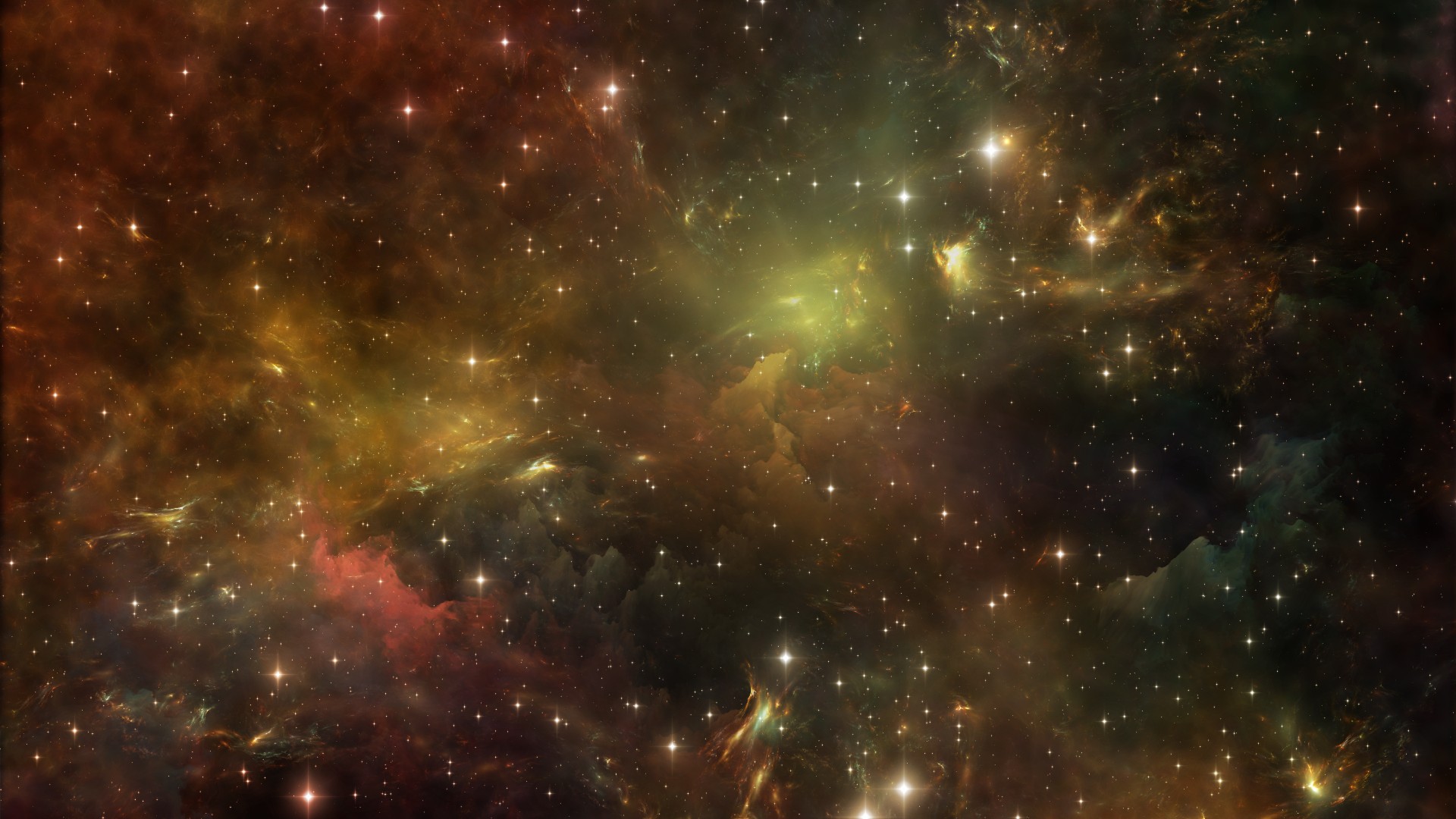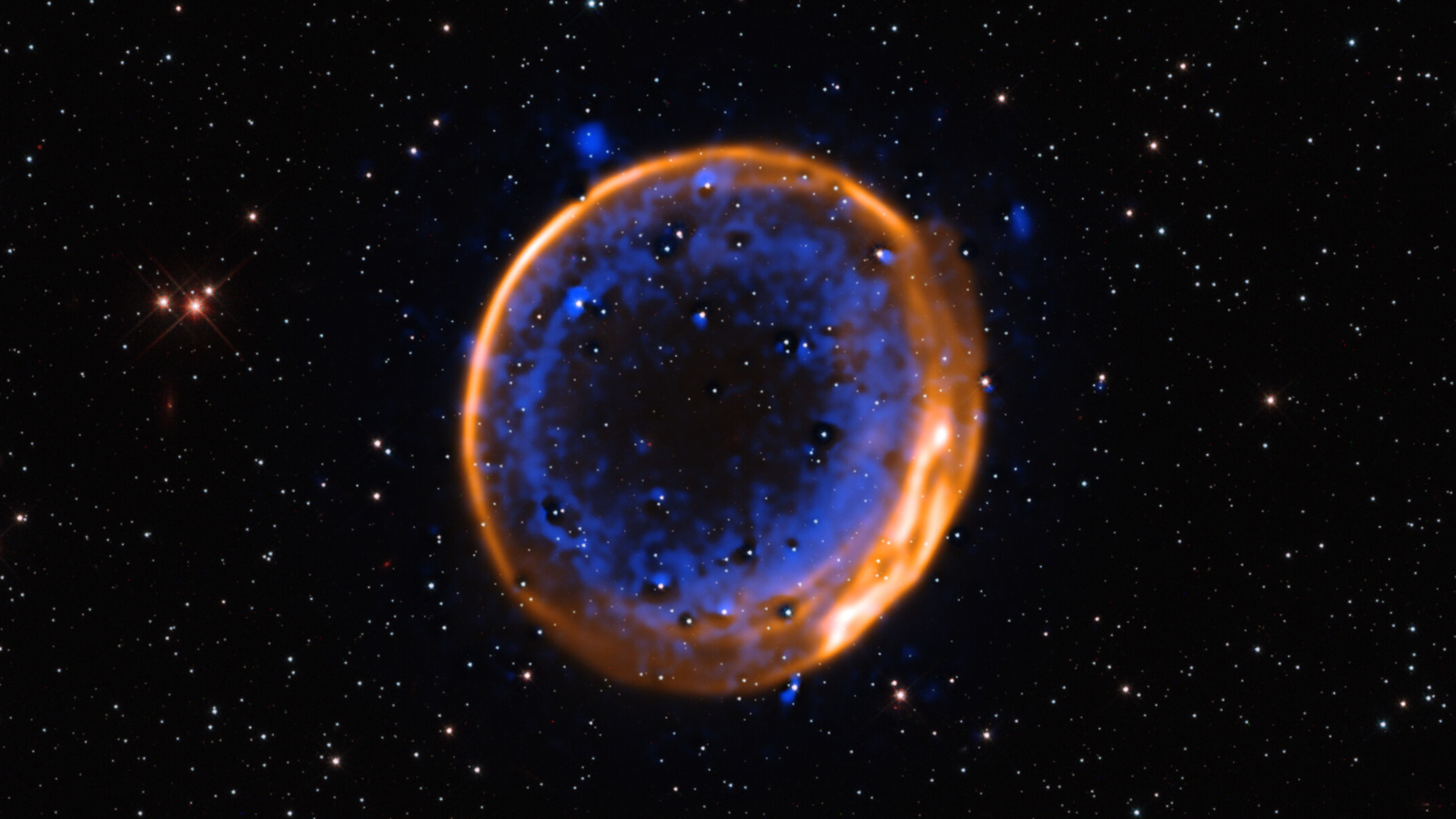Dark matter particle that may finally shed light on cosmic mystery the 'best of both worlds,' scientists say
A phase change in the early universe and particles called HYPERs could make dark matter detectable in future experiments.

A new dark matter model suggests a new candidate for the constituent particles of this mysterious form of matter that could mean it is detectable by future experiments.
Despite making up 85% of the matter in the universe, dark matter has remained frustratingly undetectable thanks to the fact that it doesn't seem to interact with light as does the "normal" everyday matter that makes up stars, planets, and us. The only way dark matter can be inferred currently is through its interaction with gravity, with this gravitational influence literally keeping galaxies from ripping apart as they spin.
The new model suggests that dark matter could be composed of what its authors call HighlY Interactive ParticlE Relics, or HYPERs. This new model suggests that after the formation of dark matter in the early universe, the strength with which it interacts with everyday baryonic matter would have increased abruptly. This HYPER model would have the consequence of making dark matter detectable in the current epoch of the universe while also offering an explanation of why dark matter is so abundant.
Related: What is dark matter?
The new model was devised by PRISMA+ Cluster of Excellence postdoctoral researcher Gilly Elor, alongside University of Michigan scientists Robert McGehee and Aaron Pierce.
"The HYPER model of dark matter asks and answers the question: How 'hyperactive' can light dark matter be?" McGehee told Space.com. "More technically, how frequently might we find light dark matter scattering off nuclei in near-future direct detection experiments that are sensitive to dark matter lighter than even a proton."
One of the current leading suspects in the hunt for dark matter candidates, are so-called "Weakly Interacting Massive Particles" or "WIMPs." The fact the search for these and other massive particles has been fruitless has led researchers to start proposing lighter particles like HYPERs as dark matter candidates.
Breaking space news, the latest updates on rocket launches, skywatching events and more!
Additionally, current dark matter investigations tend to neglect the idea of phase transitions, the change of one physical state to another such as the shift from a solid to a liquid, which are common in everyday matter.
The HYPER model instead hinges on a phase transition, demanding a transition in the early universe that changes how dark matter and everyday matter interact. The team behind the HYPER model thinks that this change of state could mean dark matter may actually be detectable in the universe as it is today.
"We found that concrete models of such dark matter may be realized if a special, new phase transition occurred in the early universe," McGehee said.

The "best of both worlds" for dark matter
The challenge faced by potential dark matter models currently is that if they suggest dark matter interacts strongly with baryonic matter, then the amount of dark matter formed in the early universe would be too small to conform with our observations of the universe. Conversely, models that produce the right amount of dark matter suggest interactions with baryonic matter that are too weak to be detected experimentally today.
The HYPER model with its phase transition suggests one single abrupt change in the interaction between dark matter and baryonic matter. This allows for what McGehee called "the best of both worlds" — both the right amount of dark matter to be created and a large enough interaction with everyday matter to be detectable.
Interactions in particle physics require a "mediator," a specific messenger particle, usually force-carrying bosons such as photons, which are messenger particles of electromagnetic force, to proceed.
Interactions between dark matter and ordinary matter would also require a mediator. The strength of the interaction would depend on the mass of the mediator particle with a larger mass meaning a weaker interaction. So the mediator in this case must be heavy enough for the correct amount of dark matter to form, while still being light enough to grant a detectable interaction with matter.
The aforementioned phase transition in the HYPER model sees the mass of the mediator particle suddenly decrease with this change occurring after the formation of dark matter. This allows for the inferred amount to be created, while simultaneously allowing for a boosted interaction with ordinary matter that leads to scattering events that could allow dark matter to be directly detectable.
While the HYPER model may address some of the challenges associated with developing a dark matter model, creating it was anything but easy.
"One thing that shocked me about this research was how hard it was to circumvent the usual constraints on dark matter," McGehee said. "When I first thought about how a phase transition could circumvent stringent cosmological constraints and provide a serious dark matter benchmark, I was extremely excited and naively expected to write a paper within a few-month time period.
"Years later, my collaborators and I had found that even the assumption of this phase transition was not enough to guarantee protection from the many serious bounds that any new model of dark matter must face and overcome."
McGehee pointed out that should a future dark matter detection experiment see what appears to be quite light dark matter scattering off nuclei frequently, the HYPER model may be the only model available to physicists to explain this observation.
"That would be an extremely exciting circumstance for myself and my co-authors," he concluded.
The team's research is published in the journal Physical Review Letters.
Follow us @Spacedotcom, or on Facebook and Instagram.
Join our Space Forums to keep talking space on the latest missions, night sky and more! And if you have a news tip, correction or comment, let us know at: community@space.com.

Robert Lea is a science journalist in the U.K. whose articles have been published in Physics World, New Scientist, Astronomy Magazine, All About Space, Newsweek and ZME Science. He also writes about science communication for Elsevier and the European Journal of Physics. Rob holds a bachelor of science degree in physics and astronomy from the U.K.’s Open University. Follow him on Twitter @sciencef1rst.
-
bwana4swahili Yet another attempt at defining nonexistent dark matter. And more research money wasted! But this search would make for a sorta interesting Sci-Fi documentary.Reply -
Manix Reply
I agree. I find it almost laughable that so much time is wasted in searching for something that doesn't exist. Funny how ghosts are dismissed because there is no evidence and yet this is EXACTLY what dark matter is ghosts. No one has seen them; detected them and we go off the "effects" happening we cannot understand. Maybe we should start looking at the facts, our science is wrong, that we are apporoaching the universel laws all wrong. it is also possible there is (and to a degree proven) that there is a FIFTH force at play in our universe. The other is that gravity as we know it doesn't act as we think it does, but depending on the circumstances there is a form of localized gravity that we're yet to understand. I am so done with them pushing the dark matter scenario as if it is FACT. it isn't. CERN hasn't discovered it and neither has any other experiment that has tested for it. It's time to swallow that pride and admit you got it wrong. Dark Matter does not exist and there is something else at play here.bwana4swahili said:Yet another attempt at defining nonexistent dark matter. And more research money wasted! But this search would make for a sorta interesting Sci-Fi documentary. -
BDL Please! Stop this utter nonsense.Reply
Every time an experiment searching for dark particles matter is carried out, and fails, another even more way-out idea for an experiment looking for another sort of dark matter particle is suggested - and again fails. So another..... I'm sure you get the drift.
I suggest we finally wake up to reality - that dark matter actually consists of teeny-tiny pink unicorns, who like playing with galaxies like their own versions of rondabouts, but that they're just very, very shy.
Let's be honest. That's a "hypothesis" with just as much validity as any of the other of these failed suggestions.
Let's get with reality. Einstein's GR is just the next level up from Newton, but it's just as much of an approximation. -
bwana4swahili Reply
The rule of the universe is the KISS principle. Dark Matter is NOT in this category! Look at something simple, like a change in the gravitational 'constant'.BDL said:Please! Stop this utter nonsense.
Every time an experiment searching for dark particles matter is carried out, and fails, another even more way-out idea for an experiment looking for another sort of dark matter particle is suggested - and again fails. So another..... I'm sure you get the drift.
I suggest we finally wake up to reality - that dark matter actually consists of teeny-tiny pink unicorns, who like playing with galaxies like their own versions of rondabouts, but that they're just very, very shy.
Let's be honest. That's a "hypothesis" with just as much validity as any of the other of these failed suggestions.
Let's get with reality. Einstein's GR is just the next level up from Newton, but it's just as much of an approximation. -
Phillip Huggan Correct. A plasma. Above -272.999999 a gas not massive. Below a different phase massive. Expansion makes things cold so partially extinguishes itself on this effect.Reply -
magnoflux Reply
Dark forces exist in space not dark planetary matter particles.Admin said:A new model for dark matter suggests an early universe phase transition and candi particles known as HYPERs could finally shed light on this mysterious matter.
Dark matter particle that may finally shed light on cosmic mystery the 'best of both worlds,' scientists say : Read more
STEVENS DEEP SPACE DARK FORCES HYPOTHESIS
No dark matter or dark energy has been found in space to balance the WMAP dark forces,but could be
1] The dark force of mass attraction G is the weakest of the dark forces in distant space.
2 The electromagnetic dark matter spin force of about 5G rotates galactic stars around a magnetic black hole hub
3. Repulsion by a near 25G dark energy force is responsible for expanding the universe as stars are assumed to have positively charged surfaces and thus repel each other electrostatically.
STEVENS DEEP SPACE DARK FORCES HYPOTHESIS
No dark matter or dark energy has been found in space to balance the WMAP dark forces, but could be
1] The dark force of mass attraction G is the weakest of the dark forces in distant space.
2 The electromagnetic dark matter spin force of about 5G rotates galactic stars around a magnetic black hole hub in x.y direction
3. Repulsion by a near 25G dark energy force is responsible for expanding the universe as stars are assumed to have positively charged surfaces and thus repel each other electrostatically.
See https://magnoflux3d.wordpress.com/ -
Questioner "The only way dark matter can be inferred currently is through its interaction with gravity,..."Reply
This is where theory is outstripping observation/data.
Again,
1) the outer edge of DM doesn't migrate inward due to its own gravity even over the billions of years of a galaxy's lifetime.
2) DM doesn't pile up around stars and planets and amplify their gravity.
3) DM isn't cascading into the central black hole of galaxies
4) there is an unexpected tight correlation between DM and central black hole masses.
..."recent studies have suggested a tight correlation between the masses of the black hole and the galaxy’s dark matter halo."
https://www.si.edu/newsdesk/releases/dark-matter-guides-growth-supermassive-black-holes
Both matter and antimatter respond to gravity,
they have to,
it is the shape space-time.
Nowhere inside a galaxy does DM respond to gravity.
"...the HYPER model may address some of the challenges associated with developing a dark matter model, creating it was anything but easy."
Struggling to pound a square peg into a round hole.
Neurotic reflex rather than cool clinical reasoning.
This is where certainty of theory gets in the way of the actual science learning process. -
magnoflux Dark matter does not exist but what does exist is a magnetic hub at the centre of every galaxy.Reply
Sagittarius A* blackhole is at central magnetic hub of our galaxy . It is 26,000 lightyears away from earth and visible from Earth through December.
As an experiment we should look at several stars of similar type and magnitude on each side of that hub; that are on the 26,000 lightyears orbit around the blackhole. If our galaxy is magnetised then the ones on one side should be slightly red shifted and going away from us and on the opposite side slightly blue shifted.
A bit of homework for you to ponder as a Christmas present. -
Unclear Engineer While I am agnostic on the reality of something to call "dark matter", I do note that this theory's "phase transition" is really nothing more than the introduction of yet another "fitting parameter" into the Big Bang Theory. According to the article, this new parameter is highly constrained by available observations, and may be disprovable by future observations.Reply
So, I say go ahead and look for the disproof. But, lack of disproof is not proof.
The only way to figure things out is to try to think of different explanation concepts and test which ones still fit when predictable observations are made.
Just posting rants on the Internet that "dark matter doesn't exist" has no scientific benefit.
Coming up with an alternative that does match the observations is what is needed. -
Questioner "Despite making up 85% of the matter in the universe..."Reply
Wow, what leap,
all there is is what appears to gravity.
"...dark matter can be inferred currently is through its interaction with gravity..."
It does not in any way interact with any gravity, including its own anywhere within a galaxy.
The only hypothetical is that DM exists and ONLY & exclusively causes gravity.
It is all presumption by simple theory fixated acolytes with zero evidence beyond what appears to be gravity.
There is a tight correlation between the size of the central black hole of any galaxy and the speculated DM there.
Does that happen by magic?
It is proposed to be in these grand sculpted 'halos' with no explanation for how that happens and why are they by in large centered around a galaxy's central black hole in galaxies.
Invisible matter needs invisible physics to sculpt it.
There is actual data of what appears to be gravity,
& thus far anything beyond that is magic pixie dust
and not evidentiary science.
Put up or shut up.
Faith in any theory is not a substitute for actual evidence.
Sheep skins are not a substitute for clear logical thinking.
